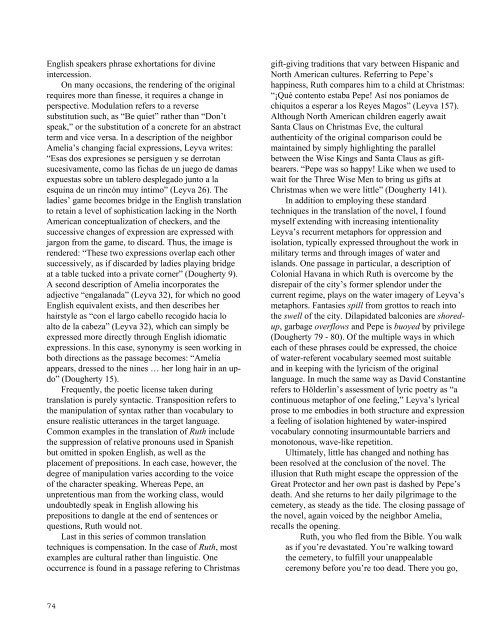their - The University of Texas at Dallas
their - The University of Texas at Dallas
their - The University of Texas at Dallas
You also want an ePaper? Increase the reach of your titles
YUMPU automatically turns print PDFs into web optimized ePapers that Google loves.
English speakers phrase exhort<strong>at</strong>ions for divine<br />
intercession.<br />
On many occasions, the rendering <strong>of</strong> the original<br />
requires more than finesse, it requires a change in<br />
perspective. Modul<strong>at</strong>ion refers to a reverse<br />
substitution such, as “Be quiet” r<strong>at</strong>her than “Don’t<br />
speak,” or the substitution <strong>of</strong> a concrete for an abstract<br />
term and vice versa. In a description <strong>of</strong> the neighbor<br />
Amelia’s changing facial expressions, Leyva writes:<br />
“Esas dos expresiones se persiguen y se derrotan<br />
sucesivamente, como las fichas de un juego de damas<br />
expuestas sobre un tablero desplegado junto a la<br />
esquina de un rincón muy íntimo” (Leyva 26). <strong>The</strong><br />
ladies’ game becomes bridge in the English transl<strong>at</strong>ion<br />
to retain a level <strong>of</strong> sophistic<strong>at</strong>ion lacking in the North<br />
American conceptualiz<strong>at</strong>ion <strong>of</strong> checkers, and the<br />
successive changes <strong>of</strong> expression are expressed with<br />
jargon from the game, to discard. Thus, the image is<br />
rendered: “<strong>The</strong>se two expressions overlap each other<br />
successively, as if discarded by ladies playing bridge<br />
<strong>at</strong> a table tucked into a priv<strong>at</strong>e corner” (Dougherty 9).<br />
A second description <strong>of</strong> Amelia incorpor<strong>at</strong>es the<br />
adjective “engalanada” (Leyva 32), for which no good<br />
English equivalent exists, and then describes her<br />
hairstyle as “con el largo cabello recogido hacia lo<br />
alto de la cabeza” (Leyva 32), which can simply be<br />
expressed more directly through English idiom<strong>at</strong>ic<br />
expressions. In this case, synonymy is seen working in<br />
both directions as the passage becomes: “Amelia<br />
appears, dressed to the nines … her long hair in an updo”<br />
(Dougherty 15).<br />
Frequently, the poetic license taken during<br />
transl<strong>at</strong>ion is purely syntactic. Transposition refers to<br />
the manipul<strong>at</strong>ion <strong>of</strong> syntax r<strong>at</strong>her than vocabulary to<br />
ensure realistic utterances in the target language.<br />
Common examples in the transl<strong>at</strong>ion <strong>of</strong> Ruth include<br />
the suppression <strong>of</strong> rel<strong>at</strong>ive pronouns used in Spanish<br />
but omitted in spoken English, as well as the<br />
placement <strong>of</strong> prepositions. In each case, however, the<br />
degree <strong>of</strong> manipul<strong>at</strong>ion varies according to the voice<br />
<strong>of</strong> the character speaking. Whereas Pepe, an<br />
unpretentious man from the working class, would<br />
undoubtedly speak in English allowing his<br />
prepositions to dangle <strong>at</strong> the end <strong>of</strong> sentences or<br />
questions, Ruth would not.<br />
Last in this series <strong>of</strong> common transl<strong>at</strong>ion<br />
techniques is compens<strong>at</strong>ion. In the case <strong>of</strong> Ruth, most<br />
examples are cultural r<strong>at</strong>her than linguistic. One<br />
occurrence is found in a passage refering to Christmas<br />
gift-giving traditions th<strong>at</strong> vary between Hispanic and<br />
North American cultures. Referring to Pepe’s<br />
happiness, Ruth compares him to a child <strong>at</strong> Christmas:<br />
“¡Qué contento estaba Pepe! Así nos poníamos de<br />
chiquitos a esperar a los Reyes Magos” (Leyva 157).<br />
Although North American children eagerly await<br />
Santa Claus on Christmas Eve, the cultural<br />
authenticity <strong>of</strong> the original comparison could be<br />
maintained by simply highlighting the parallel<br />
between the Wise Kings and Santa Claus as giftbearers.<br />
“Pepe was so happy! Like when we used to<br />
wait for the Three Wise Men to bring us gifts <strong>at</strong><br />
Christmas when we were little” (Dougherty 141).<br />
In addition to employing these standard<br />
techniques in the transl<strong>at</strong>ion <strong>of</strong> the novel, I found<br />
myself extending with increasing intentionality<br />
Leyva’s recurrent metaphors for oppression and<br />
isol<strong>at</strong>ion, typically expressed throughout the work in<br />
military terms and through images <strong>of</strong> w<strong>at</strong>er and<br />
islands. One passage in particular, a description <strong>of</strong><br />
Colonial Havana in which Ruth is overcome by the<br />
disrepair <strong>of</strong> the city’s former splendor under the<br />
current regime, plays on the w<strong>at</strong>er imagery <strong>of</strong> Leyva’s<br />
metaphors. Fantasies spill from grottos to reach into<br />
the swell <strong>of</strong> the city. Dilapid<strong>at</strong>ed balconies are shoredup,<br />
garbage overflows and Pepe is buoyed by privilege<br />
(Dougherty 79 - 80). Of the multiple ways in which<br />
each <strong>of</strong> these phrases could be expressed, the choice<br />
<strong>of</strong> w<strong>at</strong>er-referent vocabulary seemed most suitable<br />
and in keeping with the lyricism <strong>of</strong> the original<br />
language. In much the same way as David Constantine<br />
refers to Hölderlin’s assessment <strong>of</strong> lyric poetry as “a<br />
continuous metaphor <strong>of</strong> one feeling,” Leyva’s lyrical<br />
prose to me embodies in both structure and expression<br />
a feeling <strong>of</strong> isol<strong>at</strong>ion hightened by w<strong>at</strong>er-inspired<br />
vocabulary connoting insurmountable barriers and<br />
monotonous, wave-like repetition.<br />
Ultim<strong>at</strong>ely, little has changed and nothing has<br />
been resolved <strong>at</strong> the conclusion <strong>of</strong> the novel. <strong>The</strong><br />
illusion th<strong>at</strong> Ruth might escape the oppression <strong>of</strong> the<br />
Gre<strong>at</strong> Protector and her own past is dashed by Pepe’s<br />
de<strong>at</strong>h. And she returns to her daily pilgrimage to the<br />
cemetery, as steady as the tide. <strong>The</strong> closing passage <strong>of</strong><br />
the novel, again voiced by the neighbor Amelia,<br />
recalls the opening.<br />
Ruth, you who fled from the Bible. You walk<br />
as if you’re devast<strong>at</strong>ed. You’re walking toward<br />
the cemetery, to fulfill your unappealable<br />
ceremony before you’re too dead. <strong>The</strong>re you go,<br />
74

















